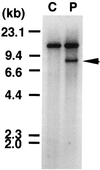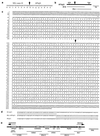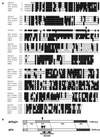AF5q31, a newly identified AF4-related gene, is fused to MLL in infant acute lymphoblastic leukemia with ins(5;11)(q31;q13q23)
- PMID: 10588740
- PMCID: PMC24471
- DOI: 10.1073/pnas.96.25.14535
AF5q31, a newly identified AF4-related gene, is fused to MLL in infant acute lymphoblastic leukemia with ins(5;11)(q31;q13q23)
Abstract
Infant acute lymphoblastic leukemia (ALL) with MLL gene rearrangements is characterized by early pre-B phenotype (CD10(-)/CD19(+)) and poor treatment outcome. The t(4;11), creating MLL-AF4 chimeric transcripts, is the predominant 11q23 chromosome translocation in infant ALL and is associated with extremely poor prognosis as compared with other 11q23 translocations. We analyzed an infant early preB ALL with ins(5;11)(q31;q13q23) and identified the AF5q31 gene on chromosome 5q31 as a fusion partner of the MLL gene. The AF5q31 gene, which encoded a protein of 1,163 aa, was located in the vicinity of the cytokine cluster region of chromosome 5q31 and contained at least 16 exons. The AF5q31 gene was expressed in fetal heart, lung, and brain at relatively high levels and fetal liver at a low level, but the expression in these tissues decreased in adults. The AF5q31 protein was homologous to AF4-related proteins, including AF4, LAF4, and FMR2. The AF5q31 and AF4 proteins had three homologous regions, including the transactivation domain of AF4, and the breakpoint of AF5q31 was located within the region homologous to the transactivation domain of AF4. Furthermore, the clinical features of this patient with the MLL-AF5q31 fusion transcript, characterized by the early pre-B phenotype (CD10(-)/CD19(+)) and poor outcome, were similar to those of patients having MLL-AF4 chimeric transcripts. These findings suggest that AF5q31 and AF4 might define a new family particularly involved in the pathogenesis of 11q23-associated-ALL.
Figures






Similar articles
-
Fusion of an AF4-related gene, LAF4, to MLL in childhood acute lymphoblastic leukemia with t(2;11)(q11;q23).Oncogene. 2003 May 8;22(18):2851-5. doi: 10.1038/sj.onc.1206389. Oncogene. 2003. PMID: 12743608
-
LAF4, an AF4-related gene, is fused to MLL in infant acute lymphoblastic leukemia.Genes Chromosomes Cancer. 2002 Sep;35(1):92-6. doi: 10.1002/gcc.10091. Genes Chromosomes Cancer. 2002. PMID: 12203795
-
A novel infant acute lymphoblastic leukemia cell line with MLL-AF5q31 fusion transcript.Leukemia. 2002 Nov;16(11):2302-8. doi: 10.1038/sj.leu.2402665. Leukemia. 2002. PMID: 12399976
-
Molecular analysis of infant acute leukemia.Leuk Lymphoma. 1997 Apr;25(3-4):191-9. doi: 10.3109/10428199709114159. Leuk Lymphoma. 1997. PMID: 9168430 Review.
-
Rearrangements involving chromosome band 11Q23 in acute leukaemia.Semin Cancer Biol. 1993 Dec;4(6):377-85. Semin Cancer Biol. 1993. PMID: 8142623 Review.
Cited by
-
Roles of a trithorax group gene, MLL, in hematopoiesis.Int J Hematol. 2005 May;81(4):288-93. doi: 10.1532/IJH97.04196. Int J Hematol. 2005. PMID: 15914356 Review.
-
The Biological Significance of AFF4: Promoting Transcription Elongation, Osteogenic Differentiation and Tumor Progression.Comb Chem High Throughput Screen. 2024;27(10):1403-1412. doi: 10.2174/0113862073241079230920082056. Comb Chem High Throughput Screen. 2024. PMID: 37815186 Review.
-
AFF4 regulates osteogenic differentiation of human dental follicle cells.Int J Oral Sci. 2020 Jun 30;12(1):20. doi: 10.1038/s41368-020-0083-9. Int J Oral Sci. 2020. PMID: 32606293 Free PMC article.
-
Common chromatin structures at breakpoint cluster regions may lead to chromosomal translocations found in chronic and acute leukemias.Hum Genet. 2006 Jun;119(5):479-95. doi: 10.1007/s00439-006-0146-9. Epub 2006 Mar 30. Hum Genet. 2006. PMID: 16572268
-
[Clinical features and prognosis in MLL-AF10 positive acute leukemia].Zhonghua Xue Ye Xue Za Zhi. 2015 Oct;36(10):840-3. doi: 10.3760/cma.j.issn.0253-2727.2015.10.007. Zhonghua Xue Ye Xue Za Zhi. 2015. PMID: 26477762 Free PMC article. Chinese.
References
Publication types
MeSH terms
Substances
Associated data
- Actions
LinkOut - more resources
Full Text Sources
Other Literature Sources
Medical
Molecular Biology Databases

